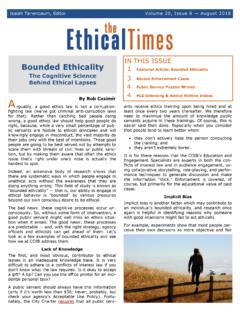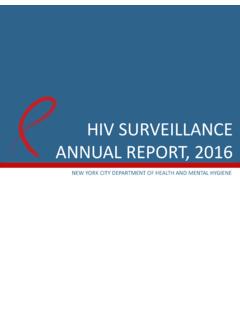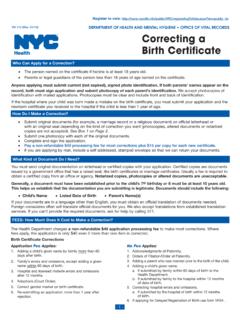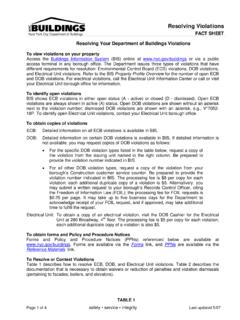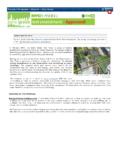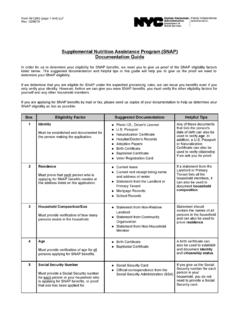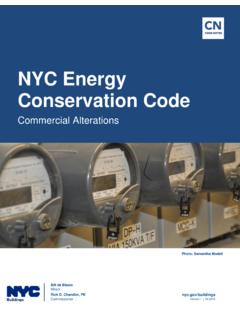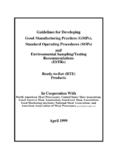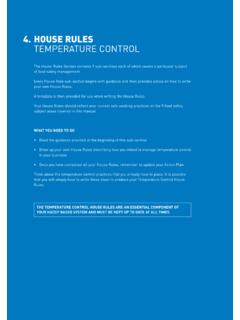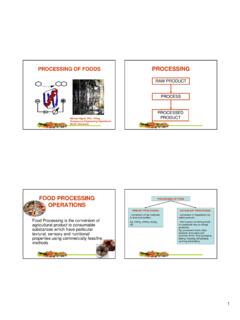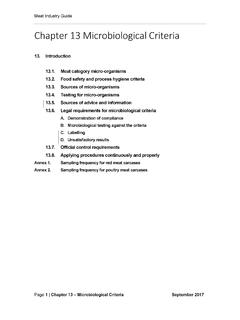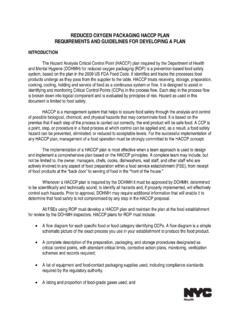Transcription of The use of glass thermometers in a food service ...
1 1 Day 1 Review All food service establishments must have a current and valid permit issued by the New York City Health Department. Health inspectors have the right to inspect any operating food service or food processing establishment. Inspectors must be given access to all areas of the establishment during an inspection. According to the New York City Health Code, supervisors of all food service establishments must have a Food Protection Certificate. Food is any edible substance, ice, beverage or ingredient used or sold for human consumption. Potentially Hazardous Foods (PHFs) are foods which support rapid growth of microorganisms.
2 Examples of PHFs include all raw and cooked meats, poultry, milk and milk products, fish, shellfish, tofu, cooked rice, pasta, beans, potatoes and garlic in oil. The Temperature Danger Zone is between 41 F and 140 F. Within this range, most harmful microorganisms reproduce rapidly. The three types of thermometers that can be used for measuring food temperatures are: bimetallic stem (range from 0 F to 220 F), thermocouple and thermistor (digital). The use of glass thermometers in a food service establishment is prohibited by law. Meat inspected by the Unites States Department of Agriculture (USDA) must have a USDA inspection stamp.
3 Smoked fish must be held at or below 38 F to prevent the growth of the bacteria Clostridium botulinum. Shellfish must be received with shellfish tags. These tags must be kept on file for at least 90 days after the product is used. Milk and milk products must either be pasteurized, with sell-by dates of 9 days, or ultra-pasteurized, with sell-by dates of 45 days. All fruits and vegetables served raw must be thoroughly washed before being served. 2 All commercial foods in modified atmosphere packaging must be used per manufacturer s specifications. Vacuum packaging of any food product in a retail food establishment is prohibited by law unless special authorization is obtained through the New York City Health Department.
4 FIFO means First In First Out. The first step in implementing the FIFO method is to date the products. The New York City Health Code requires that all food items be stored at least 6 inches off the floor. In order to prevent cross-contamination, raw foods in a refrigerator must be stored below cooked foods. Cold temperatures slow down the growth of microorganisms. All cold foods must be held at or below 41 F (except smoked fish, which must be held at or below 38 F) at all times. Keep dry storage areas well-lit and ventilated. Never store foods under wastewater lines. Stored food must be kept covered and stored in vermin-proof containers.
5 Ice intended for human consumption cannot be used for storing cans, bottles or other food products. When foods are stored directly in ice, the water from that ice must be drained constantly. The "First Aid Choking" poster must be posted in a visible (conspicuous) place in each designated eating area. Food service establishments which serve alcoholic beverages are required to display the "Alcohol and Pregnancy Warning" sign. A "Wash Hands" sign must be displayed at all hand washing sinks. "No Smoking" signs must be displayed throughout each facility. 3 Day 2 Review There are three main hazards to our health: physical, chemical and biological.
6 The presence of a foreign object ( , glass fragments, pieces of metal) in a food is considered a physical hazard. The presence of harmful chemicals ( , pesticide, cleaning agents, prescription medicine) in a food is called a chemical hazard. The presence of microorganisms (bacteria, viruses, parasites and fungi) in a food is called a biological hazard. Foods that have been contaminated with harmful (pathogenic) bacteria often do not appear to be contaminated; there is no change in appearance, taste or smell. Under favorable conditions the number of bacteria in a food can double every 20 to 30 minutes.
7 There are four phases of bacterial growth: lag, log, stationary and death. The most rapid growth of bacteria takes place in the log phase. Six factors affect the growth of bacteria: Food, Acidity, Temperature, Time, Oxygen and Moisture ( FATTOM). Viruses cannot reproduce in food. However, viruses can be transmitted to people if they get into food. Hepatitis A and norovirus are two common food-borne viruses. These viruses are transmitted when a person ingests food or water that has been contaminated with the feces of an infected person. Proper handwashing after using the toilet can prevent transmission.
8 Trichinella spiralis, which causes trichinosis, is a food-borne parasite typically found in under- cooked pork. To prevent trichinosis, cook pork to 150 F for 15 seconds. Anisakis simplex is a food-borne parasite typically found in marine fish. Salmonella enteritidis is a bacterium commonly found in raw poultry and raw shell eggs. We can control the growth of the microorganism Clostridium perfringens by rapid cooling, rapid reheating and by avoiding preparation of foods in advance. 4 Staphylococcus aureus is a bacterium that is commonly carried by healthy human beings. Staphylococcal food intoxication is a common cause of food-borne illness caused by Staphylococcus aureus, which can be prevented by good personal hygiene and avoiding bare hand contact with ready-to-eat foods.
9 Food workers with an illness that can be transmitted by contact with food or through food should not work until fully recovered. Ground meat ( , hamburgers) must be cooked to a minimum temperature of 158 F to eliminate E. coli 0157:H7. Clostridium botulinum is a bacterium that causes botulism. It is associated with home-canned foods, smoked fish, garlic in oil and any food in an anaerobic (without air) environment. Scombroid poisoning occurs from eating certain fish with high levels of histamines ( , tuna, mackerel, bonito, mahi mahi, bluefish) due to time and temperature abuse. Hands must be washed thoroughly after any activity in which they may have become contaminated.
10 For example, hands must be washed before starting work and after handling raw foods, using the toilet, coughing, sneezing, smoking, eating, drinking and scratching. The New York City Health Code requires hand washing sinks to be readily accessible within 25 feet of all food preparation areas and in or near all toilets. The hand washing sinks must be provided with soap, hot and cold running water, disposable towels or a hand dryer and a "Wash Hands" sign. The New York City Health Code requires that all food workers wear proper hair restraints, clean aprons and outer garments, and not wear any jewelry on their arms and hands (except for wedding bands and medical bracelets).
